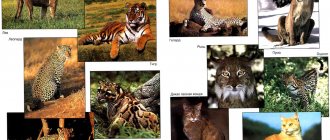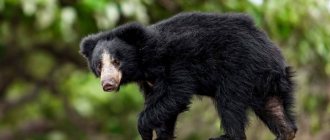This graceful animal belongs to the Feline family. Of all the tiger subspecies, the Malayan is the smallest. It has a very flexible body and a long, strong tail.
In jumping, the tiger is helped by nimble legs with low but wide forelimbs.
The paws have five toes with tenacious retractable claws. The animal has a rather heavy skull, on which neatly shaped ears are located. The Malayan tiger is especially eye-catching. His huge eyes with round pupils inspire fear in both animals and people.
You need to see the world around you in color. Nature has endowed the tiger with a strong jaw and large fangs. This helps the predator to firmly grab the prey and strangle it. The animal's tongue consists of sharp tubercles. Due to this, the tiger easily tears off the skin and meat from its prey.
Origin of the species and description
Photo: Malayan tiger
The habitat of the Malayan tiger is peninsular Malaysia (Kuala Terengganu, Pahang, Perak and Kelantan) and the southern regions of Thailand. Tigers are largely an Asian species. Back in 2003, this subspecies was classified as the Indochinese tiger. But in 2004, the population was classified as a separate subspecies - Panthera tigris jacksoni.
Prior to this, a group of American scientists from the National Cancer Institute conducted multiple genetic studies and examinations, during which, using DNA analysis, differences were identified in the genome of the subspecies, allowing it to be considered a separate species.
Video: Malayan tiger
Populations in northern Malaysia are interspersed with southern Thailand. In small forests and abandoned agricultural areas, animals are found in groups, provided there is a small population and away from major roads. In Singapore, the last Malayan tigers were exterminated in the 1950s.
According to the latest estimates, no more than 500 individuals of this species remain in nature. This elevates it to the third level of numbers among all subspecies. The Malayan tiger is most similar in color to the Indochinese tiger, and in size it is closer to the Sumatran tiger.
Interesting fact: Some myths say that the saber-toothed tiger was the forefather of all types of these predators. However, it is not. Belonging to the cat family, this species is considered more of a saber-toothed cat than a tiger.
Cultural references
The Malayan tiger is the national animal of Malaysia.[33]
Two tigers are depicted as supporters in the coat of arms of Malaysia, the coat of arms of Johor and the coat of arms of Singapore. The tiger appears in various heraldry of Malaysian institutions such as the Royal Malaysian Police, Maybank, Proton and the Football Association of Malaysia. For Malaysians, it symbolizes courage and strength. It is also the nickname for the Malaysian national football team. Malaysians have given the tiger various nicknames, notably " Pak Belang"
", which literally means "Uncle Stripes."
Pak Belang
figures prominently in folklore as one of the opponents of Pel Kansil (the mouse-deer).
The Emilio Salgari cycle of novels is about a fictional 19th-century pirate. Sandokan, the main character is known as the "Tiger of Malaysia".[34]
Appearance and features
Photo: Animal Malayan tiger
Compared to its relatives, the Malayan tiger is small in size:
- Males reach 237 cm in length (including tail);
- Females - 203 cm;
- The weight of males is within 120 kg;
- Females weigh no more than 100 kg;
- The height at the withers ranges from 60-100 cm.
The body of the Malayan tiger is flexible and graceful, the tail is quite long. Massive heavy head with a large facial skull. Under the round ears are fluffy whiskers. Large eyes with round pupils see everything in color. Well developed night vision. Vibrissae are white, elastic, arranged in 4-5 rows.
They have 30 powerful teeth in their mouth, and the fangs are the longest in the family. They promote a strong grip on the victim's neck, which allows them to choke him until he stops showing signs of life. The canines are large and curved, sometimes the length of the upper teeth reaches 90 mm.
Interesting fact: Thanks to a long and mobile tongue with sharp tubercles, completely covered with hardened epithelium, the Malayan tiger can easily tear off the skin from the victim’s body and the meat from its bones.
There are five toes on the strong and wide front paws, and four toes on the hind paws with fully retractable claws. The fur on the paws and back is thick and short, while on the belly it is longer and fluffier. The orange-orange body is crossed by dark transverse stripes. There are white spots around the eyes, on the cheeks and near the nose. The belly and chin are also white.
Most tigers have more than 100 stripes on their bodies. On average, there are 10 transverse stripes on the tail. But they also meet from 8-11. The base of the tail is usually not framed by solid rings. The tip of the tail is always black. The main purpose of stripes is camouflage when hunting. Thanks to them, a tiger can hide in the thickets for a long time without being noticed.
Fun Fact: Each animal has its own unique set of stripes, which helps differentiate them from each other. Tigers also have striped skin. If the animals are clipped, dark fur will grow on the dark stripes, the pattern will be restored and become identical to the original.
Liger
Liger is a hybrid that is the result of mating between a male lion and a tigress. The lion contributes a gene that promotes growth, because of this, ligers can grow much larger than their parents and have a length of 3-3.5 m, and a weight of 360 kg to 450 kg or even more. They do, however, reflect the appearance and behavior of both parents. As a result, the liger has spots and stripes imprinted on its sandy fur. Male ligers have a 50% chance of growing a mane, just not as luxurious as a lion's. While the resulting liger is certainly beautiful and interesting to study, the males of this hybrid are sterile, even when their females are usually fertile.
On the Topic: 18 ANIMAL HYBRIDS YOU'VE NEVER SEEN
Tigon
The tigon , which is the result of breeding between a male tiger and a lioness, is a less common hybrid. Naturally, tiger hybrids cannot; they are found in the wild and can only be seen in zoos or circuses. Tigons are usually no larger than average in size.
Where does the Malayan tiger live?
Photo: Malayan Tiger Red Book
Malayan tigers prefer mountainous, hilly terrain and live in forests, often located on borders between countries. They navigate well in impenetrable jungle thickets and easily cope with water obstacles. They can jump up to 10 meters. They climb trees well, but do this only in extreme cases.
They equip their homes:
- in rock crevices;
- under the trees;
- in small caves the ground is lined with dry grass and leaves.
People are avoided. They can settle in fields with moderate vegetation. Each tiger has its own territory. These are quite vast areas, sometimes reaching up to 100 km². The territories of females may overlap with those of males.
Such large numbers are explained by the small amount of production in these places. The potential habitat of wild cats is 66,211 km², while the actual habitat is 37,674 km². Now the animals live on an area not exceeding 11,655 km². Thanks to the expansion of protected areas, the actual area is planned to increase to 16,882 km².
These animals have a high ability to adapt to any environment: be it the humid tropics, rocky cliffs, savannas, bamboo groves or impenetrable jungle thickets. Tigers feel equally comfortable in hot climates and in snowy taiga.
Interesting fact: The Malayan tiger is given cultural significance as it is featured on the country's coat of arms. In addition, it is the national symbol and logo of Maybank, the Malaysian bank, and the army.
Lifestyle
Males are predisposed to a solitary lifestyle. Each tiger must be assigned an individual plot, the area of which ranges from 26 to 78 km2. This size depends on how much prey there is in a given area. The tiger necessarily marks its part of the territory. Young tigers have to find their own area of land to live and hunt, often winning it over from adult males. The male will never tolerate a stranger being in his territory and will try to expel him.
What does the Malayan tiger eat?
Photo: Malayan tiger
The main diet consists of artiodactyls and herbivores. Malayan tigers feed on deer, wild boars, sambars, gaurs, langurs, and hunt muntjacs, serows, long-tailed macaques, porcupines, wild bulls and red deer. They did not avoid and fell. As you can see, these animals are not picky when it comes to food.
Occasionally they chase hares, pheasants, small birds, and mice and voles. Especially brave ones can attack the Malayan bear. On a particularly hot day, you won’t mind hunting fish and frogs. They often attack small elephant calves and domestic animals. In summer they can eat nuts or tree fruits.
Thanks to their thick layer of fat, tigers can go without food for a long time without causing damage to their health. In one sitting, wild cats can eat up to 30 kg of meat, and very hungry cats can eat up to 40 kg. Predators do not suffer from lack of appetite.
In captivity, the diet of tigers is 5-6 kg of meat 6 days a week. When hunting, they use their sight and hearing more than relying on their sense of smell. A successful hunt can take up to 10 attempts. If none of them succeeds or the victim turns out to be stronger, the tiger no longer pursues it. They eat lying down, holding food with their paws.
Hunting
The Sumatran tiger always attacks first. Mostly the predator catches its prey alone. He sniffs out the victim, sneaks up from behind and attacks. The predator loves to drive ungulates into a body of water, since it itself swims well. In general, Sumatran tigers are delighted with water. They love to take water procedures and finish off prey in a pond. During hot weather they lie in the water most of the day.
We recommend reading the article:
What are the most beautiful cats?
The victim of the smallest tiger in the world can be a careless person, whom the animal watches from behind the bushes, at an opportune moment jumps on him, knocks him to the ground and kills him.
In winter, the Sumatran tiger searches for food during the day, in summer - at night. Their food includes muntjacs, wild boars, badgers, and orangutans. They eat kanchili and sambar. They can also hunt crocodiles that significantly exceed their weight. At one time, a predator can eat 18 kg of meat and remain full for three whole days after that. At the zoo, tigers are fed fish, poultry, and meat. Vitamins are added to food.
Features of character and lifestyle
Photo: Malayan tiger animal
Possessing enormous strength, tigers feel like full masters of the area they occupy. They mark territory everywhere with urine, mark the boundaries of their possessions, stripping the bark from trees with their claws and loosening the ground. In this way they protect their territories from other males.
Tigers that live in the same domain are friendly to each other, coexist peacefully, and when they meet, they touch each other with their muzzles and rub their sides. As a sign of greeting, they snort and purr loudly, while noisily exhaling air.
Wild cats hunt at any time of the day. If tasty prey turns up, the tiger will not miss it. Being able to swim well, they successfully hunt fish, turtles or small crocodiles. With a heavy paw, they make a lightning strike on the water, stunning the prey and eating it with pleasure.
Although Malayan tigers are generally solitary, they sometimes gather in groups to share particularly large prey. When an attack on a large animal is successful, tigers emit a loud roar that can be heard very far away.
Animals communicate using sound, smell and visual communication. If necessary, they can climb trees and make jumps up to 10 meters in length. During the hottest time of day, tigers like to spend a lot of time in the water, escaping the heat and annoying flies.
Interesting fact: The Malayan tiger's vision is 6 times sharper than a human's. At dusk, they have no equal among hunters.
CONTENT
In the Middle English Tiger
and Old English
Tigras
derives from Old French
Tigre
, from Latin
Tigris
.
This was a borrowing of the Classical Greek τίγρις "tiger", a foreign loan of unknown origin meaning "tiger" and the Tigris River. The origin may have been from the Persian word tigra,
meaning "pointed or sharp", and the Avestan word
tigrhi
"arrow", possibly referring to the speed of a tiger's leap, although these words are not known to have any meaning associated with tigers.
Common name Panther
comes from the Latin word
panthera
and the ancient Greek word πάνθηρ "panther". In Sanskrit Word work पाण्डर PAND-ara means “pale yellow, whitish, white.
Source
Tigers have always fascinated people with their power, predatory grace and incredible beauty. Translated from the ancient Persian language, their name sounds like “fast or sharp,” which fully corresponds to these huge cats, because tigers are unsurpassed hunters who overtake their prey with a lightning-fast jump and can kill a buffalo with one blow of their paw.
Social structure and reproduction
Photo: Malayan tiger cub
Although tigers breed throughout the year, the peak of this period occurs in December-January. Females mature for mating at 3-4 years, while males mature only at 5. Usually males choose 1 female for courtship. In conditions of increased density of male tigers, fights for chosen ones often occur.
When females go into heat, they mark their territory with urine. Since this can happen every few years, there are bloody battles over tigresses. At first, she does not allow males to approach her, hissing at them, growling and fighting back with her paws. When the tigress allows you to approach her, they mate many times over the course of several days.
During estrus, females can mate with several males. In this case, the litter will contain babies from different fathers. Males can also mate with multiple tigresses. After giving birth, the female zealously protects her offspring from males, because they can kill the kittens so that she will go into heat again.
On average, gestation lasts around 103 days. There can be from 1 to 6 babies in a litter, but on average there are 2-3. Children are fed with mother's milk for up to six months, and at about 11 months they begin to hunt on their own. But until they are 2-3 years old, they will still live with their mother.
Sociality
Animals of this species are accustomed to living separately. They occupy a vast territory, the size of which depends on the amount of prey in the area. The exception is mothers who live with their offspring for up to one and a half years, teaching them all the intricacies of hunting. In some cases, males live with females until the cubs grow up. Young males occupy large territories. They mark their place with urine, feces, and make marks on trees. If the territory is occupied, then they enter into battle, where the strongest wins. Sometimes the son drives his father away. They do not allow other tigers to live near them, but they are allowed to pass here.
Natural enemies of Malayan tigers
Photo: Malayan tiger
Thanks to their powerful constitution and enormous strength, adult tigers have practically no enemies. These animals are at the top of the food pyramid among other animals. Well-developed intuition helps them quickly assess the situation and act according to their instincts.
The main persecutors of Malayan tigers are poachers with guns, unscrupulously shooting animals for commercial gain. Tigers are wary of elephants, bears and large rhinoceroses, trying to avoid them. Kittens and young tiger cubs are hunted by crocodiles, wild boars, jackals, porcupines and wild dogs.
As old or crippled animals begin to prey on livestock and even people, local residents shoot the tigers. Between 2001 and 2003 alone, 42 people were killed by Malayan tigers in the mangrove forests of Bangladesh. People use tiger skins as decoration and souvenirs. Tiger meat is also used.
Malayan tiger bones are often found on black markets in Asia. And in medicine, body parts are used. Asians believe that bones have anti-inflammatory properties. The genitals are considered a powerful aphrodisiac. The main reason for the decline of the species was sport hunting of these animals in the 30s of the 20th century. This greatly reduced the population of the species.
Recommendations
- ^ a b c
Kawanishi, K. (2015).
« Panthera tigris
subsp.
Jacksony
."
IUCN Red List of Threatened Species
.
2015
: e.T136893A50665029. - ^ a b c
Luo, S.-J.;
Kim, J.-H.; Johnson, W. E.; van der Walt, J.; Martenson, J.; Yuhki, N.; Miquelle, D.G.; Ufirkina, O.; Goodrich, J.M.; Quigley, H.B.; Tilson, R.; Brady, G.; Martelli, P.; Subramaniam, V.; McDougal, C.; Hean, S.; Huang, S.-Q.; Pan, W.; Karanth, UK.; Sunquist, M.; Smith, J.L.D.; O'Brien, S. J. (2004). "Phylogeography and genetic origins of tigers ( Panthera tigris
)".
PLOS Biology
.
2
(12):e442. Doi:10.1371/journal.pbio.0020442. PMC 534810. PMID 15583716. - ^ a b
Schirmer, E. M. (2012).
"4: When there were tigers in Singapore." When There Were Tigers in Singapore: A Family Saga of the Japanese Occupation
. Singapore: Marshall Cavendish International Asia Pte Ltd. paragraph 50. ISBN 978-9-8144-0884-4. - ^ a b
Jaafar, H. Z. E., & Ashraf, M. A. (2017).
"1: Climate, ecosystem, flora and fauna." In Ashraf, M. A.; Osman, R. and Ishak, K. F. (Eds.). Soils of Malaysia
. CRC Press. ISBN 978-1-3519-9857-4. - ^ a b
Kitchener, A. S.;
Breitenmoser-Würsten, C.; Eizirik, E.; Gentry, A.; Werdelin, L.; Wilting, A.; Yamaguchi, N.; Abramov, A. V.; Christiansen, P.; Driscoll, C.; Duckworth, J. W.; Johnson, W.; Luo, S.-J.; Meijaard, E.; O'Donoghue, P.; Sanderson, J.; Seymour, K.; Bruford, M.; Groves, C.; Hoffmann, M.; Nowell, K.; Timmons, Z.; Tobe, S. (2017). "Revised Taxonomy of Felids: Final Report of the Cat Classification Working Group of the IUCN Felid Specialist Group" (PDF). Cat News
. Special issue 11: 66–68. - Wilkinson, R. J. (1901). Malay-English Dictionary
. Hong Kong, Shanghai and Yokohama: Kelly & Walsh Limited. - Linnaeus, C. (1758). " Felis tigris
".
Caroli Linnæi Systema natur per regna tria naturæ, minor classes, ordinal, genera, species, cum characteribus, differentials, synonyms, loci.
Tomus I (Decima, reformatted ed.). Kholmiya: Lavrentiy Salviy. paragraph 41. - Mazak, W. (1968). "Nouvelle sous-espèce de tigre provanant de l'Asie du Sud-est." Mammals
.
32
(1): 104−112. doi:10.1515/mamm.1968.32.1.104. S2CID 84054536. - ^ a b c
Khan, M.K.M.
(1986). "Tigers in Malaysia". Journal of Wildlife and Parks
.
V
: 1–23. - Liu, Y.-C.; Sun, X.; Driscoll, C.; Miquelle, D. G.; Xu, X.; Martelli, P.; Ufirkina, O.; Smith, J.L.D.; O'Brien, S. J.; Luo, S.-J. (2018). "Genome-wide evolutionary analysis of the natural history and adaptation of the world's tigers." Current Biology
.
28
(23):3840–3849. doi:10.1016/j.cub.2018.09.019. PMID 30482605. - Peng, L. Y. (2004). "Research Team: New Malayan Tiger Subspecies". Star online
. Malacca. Received 2019-08-10. - O'Brien, S. J.; Luo, S.-J.; Kim, J.-H.; Johnson, W. E. (2005). “Molecular genetic analysis has identified six living subspecies of the tiger. Panthera tigris
.
42
. Cat News: 6-8. Magazine citation required | log = (help) - McMullin, A. (2005). "IUCN tiger specialist Peter Jackson earns his stripes." International Union for Conservation of Nature, Iron.
- Mazak, J. H.; Groves, S. P. (2006). "Taxonomic Revision of Tigers (Panthera tigris)" (PDF). Biology of Mammals
.
71
(5):268–287. doi:10.1016/j.mambio.2006.02.007. Archived March 13, 2013.CS1 maint: BOT: Source URL status unknown (link) - Locke, A. (1956). Tigers of Terengganu
. London: Museum Press Ltd. - ^ a b c
Kawanishi, K.;
Yatim, S. H.; Abu Hashim, A.K.; Topani, R. (2003). "Distribution and Potential Abundance of Tigers in Peninsular Malaysia". Journal of Wildlife Parks (Malaysia)
.
21
: 29–50. Archived from the original on 2012-04-06. - Hans, J. (2014). "The Malayan tiger population is declining to 250-340 individuals." Mongabay.
- ^ a b
"Poachers and limited prey are pushing the Malayan tiger to the brink of extinction."
Bernama
. Kuala Lumpur: Free Malaysia today. 2022. Retrieved 2019-08-10. - ^ a b
Yahaya, A. M. (07/30/2019).
"Poachers and limited prey are driving the Malayan tiger to extinction." Star online
. Kuala Lumpur. Received 2019-08-10. - ^ a b
Arif, Z. M. (2019-08-03).
“The Malayan tiger is teetering on the brink of extinction; 23 remain in the Belum-Temenggor Forest Reserve.” New Times of the Strait
. Gerik. Received 2019-08-10. - Kawanishi, K.; Sunquist, M. E. (2004). "Conservation status of tigers in primary tropical forests of Peninsular Malaysia". Biological conservation
.
120
(3):329–344. doi:10.1016/j.biocon.2004.03.005. - Yong, D. L.; Lee, P.Y.-H.; Ang, A.; Tan, K. H. (2010). “Status on Singapore Island of the Eurasian wild pig. Sus scrofa
(Mammals: Suidae)" (PDF).
Nature of Singapore
.
3
: 227–237. - Ickes, K.; Paciorek, C.J.; Thomas. S. S. (2005). "Effects of nest building by native pigs ( Sus scrofa
) on Malaysian lowland tropical forest seedlings" (PDF).
Ecology
.
86
(6):1540–1547. Doi:10.1890/04-0867. JSTOR 3450779. Archived from the original (PDF) on 2011-07-20. Retrieved 2010-10-03. - Ickes, K. (2001). "Abundance of native wild pigs ( Sus scrofa
) in the lowland tropical dipterocarp forest of Peninsular Malaysia."
Biotropica
.
33
(4):682–690. Doi:10.1646/0006-3606(2001)033[0682:haonwp]2.0.co; 2. JSTOR 3593170. - Shevade, V.S.; Potapov P.V.; Harris, N. and Loboda, T.V. (2017). "The expansion of industrial plantations continues to threaten the Malayan tiger's habitat." Remote sensing
.
9
(7): 747. doi:10.3390/RS9070747. - ^ a b
Nowell, K. (2007).
Asian big cat conservation and trade control in selected range states: assessing the implementation and effectiveness of CITES recommendations
(PDF). Cambridge, UK: Traffic International. - Shepherd, C.R.S.; Khan, S.; Krishnasamy, K. (2013). "Largest tiger capture in Malaysia." Cat News
(59): 11. - Shahar, F. M. (2013). "Take action with Maybank Wild Tiger Run." New Times of the Strait
. Archived from the original on 2014-10-25. Retrieved 2014-09-18. - Sundararaj, A. (2013). "Tigers are our heritage." New Times of the Strait
. Archived from the original on 2014-10-25. Retrieved 2014-09-18. - “The Tiger Hotline has received a good response from the public.” Star
. 2007. Archived from the original on 2017-07-30. Retrieved 2014-09-18. - Haing, N. (2013). “Nature lovers pursue poachers to prevent illegal hunting.” Star
. Archived from the original on 2016-03-15. Retrieved 2014-09-18. - Lee, P. (2014). “The Malayan tiger is critically endangered, there are only 250 of them.” Star
. Retrieved 2014-09-18. - DiPiazza, F. (2006). Malaysia in pictures
. Books of the twenty-first century. ISBN 978-0-8225-2674-2. - Adami, S. (2006). "Emilio Salgari (1862–1911)". In Marrone, G.; Puppa, P. (ed.). Encyclopedia of Italian Literary Studies
. New York, London: Routledge. pp. 1654–1655. ISBN 9781135455309.
Population and species status
Photo: Animal Malayan tiger
The approximate number of Malayan tigers living on the planet is 500 individuals, of which about 250 are adults, which makes their species endangered. The main threats are deforestation, poaching, loss of habitual habitat, conflicts with people, and competition with domestic animals.
At the end of 2013, environmental organizations placed camera traps in the habitats of big cats. From 2010 to 2013, up to 340 adult individuals were recorded, excluding isolated populations. For a large peninsula this is a very small figure.
Uncontrolled deforestation for the construction of oil palm plantations and water pollution from industrial wastewater become serious problems for the survival of the species and lead to loss of habitat. Over the course of one generation, the population declines by about a quarter.
According to researchers, at least 94 Malayan tigers were confiscated from poachers between 2000 and 2013. Agricultural development is also detrimental to the tiger population due to habitat fragmentation.
Despite the popularity of tiger body parts in Chinese medicine, there is absolutely no scientific evidence to support the value of tiger organs or bones. It should be noted that Chinese law prohibits any use of tiger bodies for the purpose of obtaining medicine. The poachers themselves will face the death penalty.
Habitats
Tigers of this species live in the jungle. They can also be found in mountain, lowland or plain forests. Their life expectancy in the natural environment is 10-15 years; in captivity they can live up to 20 years. In order to preserve the species, breeding programs are provided.
This breed of tiger is considered the purest. Genetic engineering studies have shown that the subspecies is unique, since the animals lived for a long period in isolation from other species of tigers and retained the genetic code of their prehistoric counterparts. The habits and appearance of Sumatran tigers differ from animals living on the mainland.











